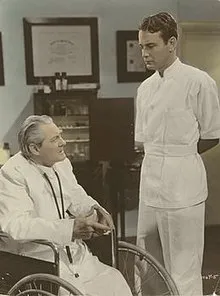
Dr. James Kildare is a fictional American medical doctor character, originally created in the 1930s by the author Frederick Schiller Faust under the pen name Max Brand. Shortly after the character's first appearance in a magazine story, Paramount Pictures used the story and character as the basis for the 1937 film Internes Can't Take Money. Metro-Goldwyn-Mayer (MGM) subsequently acquired the rights and featured Kildare as the primary character in a series of American theatrical films in the late 1930s and early 1940s, several of which were co-written by Faust (as Max Brand), who also continued to write magazine stories and novels about the character until the early 1940s. The Kildare character was later featured in an early 1950s radio series, a 1960s television series, a comic book and comic strip based on the 1960s TV show, and a short-lived second 1970s television series. The Kildare character first appeared on radio on October 13, 1938, when Lionel Barrymore and Lew Ayres performed a scene from their soon-to-be-released film, Young Dr. Kildare, on MGM's Good News of 1939 radio program.
In 1942, during the making of the tenth film in the MGM series, originally titled Born to Be Bad, Ayres was drafted to serve in WWII and declared himself a conscientious objector. The resulting negative publicity caused MGM to cut Ayres from the film, eliminate the character of Kildare, and change the film's focus to Barrymore's character Gillespie, eventually releasing the revamped film as Calling Dr. Gillespie (1942).
In the summer of 1949, MGM reunited Lew Ayres and Lionel Barrymore to record the radio series, The Story of Dr. Kildare, which used the concept and characters of the earlier Young Dr. Kildare story and did not include any of the young doctors who had replaced Kildare in the later films featuring Dr. Gillespie. By this time, Ayres (his leading role in the original version of All Quiet on the Western Front (1930) that made him a star, secured him a contract with Universal—and made him a conscientious objector to World War II) had returned to public favor after serving in WWII as a medical corpsman. Episodes were scripted by James Moser, Jean Holloway, Les Crutchfield, E. Jack Newman, John Michael Hayes, Joel Murcott, and others. The supporting cast included Ted Osborne as hospital administrator Dr. Carew, Eleanor Audley as receptionist Molly Byrd, Jane Webb as nurse Mary Lamont, and Virginia Gregg as nurse Evangeline Parker, labeled "Nosy Parker" by Gillespie. In addition, many prominent West Coast radio actors made recurring appearances, including Raymond Burr, William Conrad, Stacy Harris, Lurene Tuttle, Barton Yarborough, and Jack Webb.
Each radio episode was developed as a stand-alone program rather than a serial. Episodes typically focused on Dr. Kildare dealing with a particular medical issue while jousting with eccentric patients and/or hospital administrators. The medical information presented was up to date for its time, and sometimes taken from real life; for example, an episode in which Dr. Kildare is forced to perform an emergency appendectomy on himself was based on a news story. At least 60 half-hour episodes were produced.
In addition to airing on the MGM-affiliated New York station WMGM, The Story of Dr. Kildare was originally syndicated to over 200 outlets in the U.S. and Canada, mostly Mutual Broadcasting System stations. The earliest known broadcast of the program took place on September 27, 1949, on Mutual station WGN in Chicago, prior to the WMGM premiere episode on October 12, 1949. In the early 1950s, MGM offered the show to stations as part of a multiple-program package for a price lower than purchasing each program individually. However, starting in 1952, stations began to lose interest in such packages, preferring to develop their own local programming to better compete with television. Consequently, despite the show's popularity with audiences, no new episodes of The Story of Dr. Kildare were produced after 1951, although rebroadcasts of old episodes continued to air in syndication for several more years.
Angela and Steven Kester